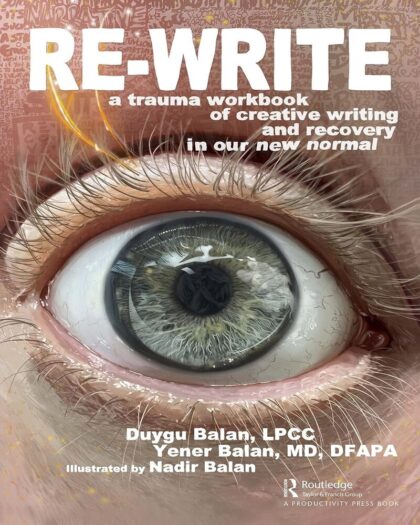Re-Write employs practical strategies using evidence-based methodologies with psychological theory within a human-centered design framework.
Not long ago, cognitive behavioral therapy and medication management were the mainstays for trauma-informed care. Now more than ever, patients and clinicians alike are seeking deeper, more somatic, and holistic attachment theory-based forms of treatment to re-write the trauma narrative, such as somatic psychology and Eye Movement Desensitization and Reprocessing (EMDR).
The pandemic brought about significant changes in our stability, sense of community, and political and economic landscapes. Because of this added stress, we’re all experiencing a heightened level of sensitivity, which has resulted in multifactorial trauma responses, an impact that spans nations, ages, and socioeconomic statuses.
Re-Write focuses on the healing journey of the trauma survivor, utilizing easy-to-use methodologies for long-lasting effects. Readers can use the workbook in whatever order they choose, experiment with different techniques from different modalities, and find the ones that meet their needs the best.
In this book, readers will get:
- Various exercises within trauma-healing methods
- Specific writing prompts that encourage processing and healing
- Coping mechanisms you can utilize in everyday life
- Customizable soothing techniques
















The book is accessible for folks like me who aren’t therapists or psychologists. Schwartz explains how he began to apply his knowledge of family systems to what he identifies as different parts we have within us that relate to 1 another much like our external families do. We have parts that, often at a young age, were traumatized & become frozen in that time period. Protector parts developed, sending vulnerable parts into exile, & may become triggered by anything that threatens the safety of our exiles. When we become aware of, listen to, & work with our protectors, we can gain their trust so they will stand down &allow us to find & heal our exiles. Then the protector parts are freed up to serve healthier functions.
Schwartz includes transcripts to model how this work is done with his clients. He provides exercises for readers to try on their own & gives recommendations regarding at what point to seek help from an IFS-trained therapist. This model fits in perfectly with Enneagram work & the idea of nonjudgmental self-observation, as well as self-compassion. It feels a bit odd at first, but it makes a lot of sense & has been really helpful for me. One of my favorite things about this model is Schwartz’s assertion that we all inherently have what we need to heal (though we may need a therapist to guide us), & once the Self emerges (or what we would call “True Self” or “Essence” in Enneagram work), the Self seems to know what to do to respond compassionately to the parts & exiles in a way that is healing.
I highly recommend this book & am excited to continue practicing & learning about IFS! This would be a great one to read and study in community.